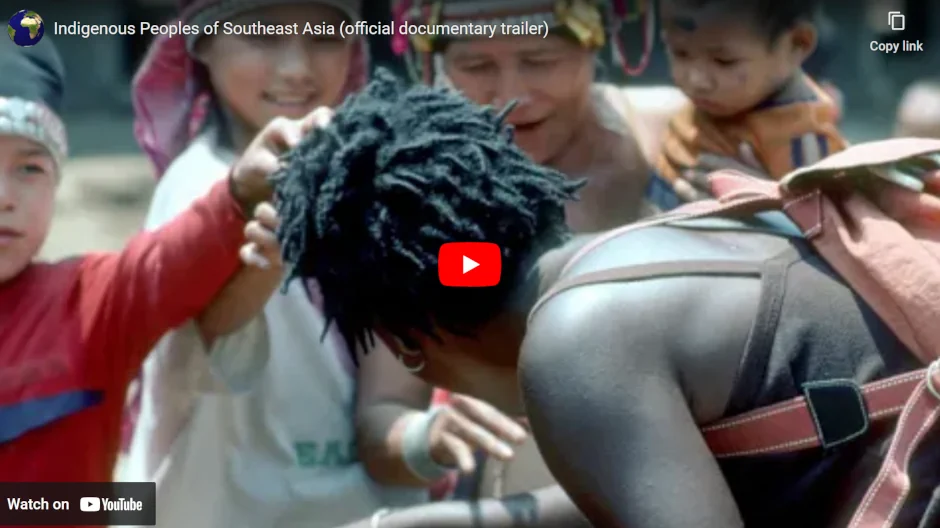Southeast Asia Travel Narrative Story: An Ethnic Journey through Shan State, Burma (Myanmar)
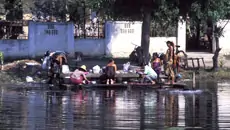
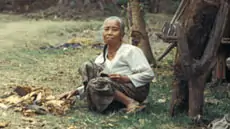 I'd spent an unforgettable time at Inle Lake in the southern part of Burma's Shan State. One of the highlights
of that journey was visiting Mine Thauk Orphanage.
Now it was time to leave and head north. I took a 20-minute ride by local bus from Nyaung Swhe town to the main
road and waited... and waited. Finally a bus arrived and a few hours later I was at my next destination, Kalaw.
I'd spent an unforgettable time at Inle Lake in the southern part of Burma's Shan State. One of the highlights
of that journey was visiting Mine Thauk Orphanage.
Now it was time to leave and head north. I took a 20-minute ride by local bus from Nyaung Swhe town to the main
road and waited... and waited. Finally a bus arrived and a few hours later I was at my next destination, Kalaw.
Most travelers don't stop in Kalaw — instead preferring to continue their journey through the night all the way
to Mandalay.
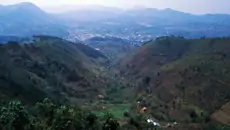
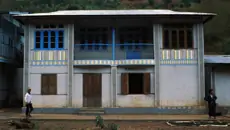 Those who do stop here take the opportunity to visit Karen, Palaung and Taungyo villages.
There are a handful of tour guides in town who can take you to these villages and I spent a few hours shopping around. In
the end, a guide originally from Nepal seemed to be the best choice and early the next morning
I set out for a three-day hike into the mountains with the guide, a porter and a cook.
Those who do stop here take the opportunity to visit Karen, Palaung and Taungyo villages.
There are a handful of tour guides in town who can take you to these villages and I spent a few hours shopping around. In
the end, a guide originally from Nepal seemed to be the best choice and early the next morning
I set out for a three-day hike into the mountains with the guide, a porter and a cook.
We walked for about twenty kilometers on the first day. We visited Karen and Palaung villages and I was very
 surprised to see how modern some of them were considering the country I was in.
surprised to see how modern some of them were considering the country I was in.
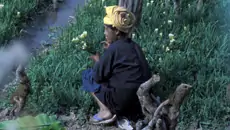 My guide had planned for us to stay overnight in the last Karen village that we'd visited. But unexpected
events made that plan impossible. So instead we walked to a monastery a further thirty minutes up a large
hill from the village. The facilities were basic and after taking a cold shower dinner was ready. The food
and the surroundings were soothing and I slept that night with a spiritual comfort I hadn't experienced before.
My guide had planned for us to stay overnight in the last Karen village that we'd visited. But unexpected
events made that plan impossible. So instead we walked to a monastery a further thirty minutes up a large
hill from the village. The facilities were basic and after taking a cold shower dinner was ready. The food
and the surroundings were soothing and I slept that night with a spiritual comfort I hadn't experienced before.
The next morning we left the monastery and headed out for a Karen village where a wedding was taking place.
My guide assumed I wouldn't have much interest in the wedding and instead suggested that we visit a local
waterfall.
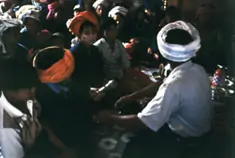
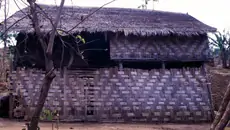 Attending a wedding in any culture outside my own has always been fascinating to me and I wasn't
about to pass up my first chance to attend a Karen wedding for a waterfall! I saw little of my guide for the next
four hours. It almost felt like I was one of the villagers — they made me so welcome and were themselves
fascinated that an outsider like me would have such an interest in their local event.
Attending a wedding in any culture outside my own has always been fascinating to me and I wasn't
about to pass up my first chance to attend a Karen wedding for a waterfall! I saw little of my guide for the next
four hours. It almost felt like I was one of the villagers — they made me so welcome and were themselves
fascinated that an outsider like me would have such an interest in their local event.
Too soon it was time to leave. I gave my thanks and good-byes
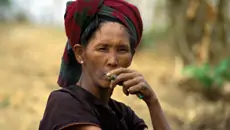 and we were on our way to visit Taungyo villages en route back to Kalaw. During the seventeen kilometer
walk we visited three or four Taungyo villages, spending the night in the last one.
and we were on our way to visit Taungyo villages en route back to Kalaw. During the seventeen kilometer
walk we visited three or four Taungyo villages, spending the night in the last one.
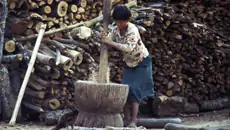 Again, the food and the
surroundings were beyond what I could have expected and the hospitality I'd experienced in each village continued
to make this leg of my journey one that I would not forget for a long time.
Again, the food and the
surroundings were beyond what I could have expected and the hospitality I'd experienced in each village continued
to make this leg of my journey one that I would not forget for a long time.
We arrived back in Kalaw in the early afternoon. I was sad to be leaving this part of Shan State after such wonderful times but it was, once again, time to move on. The bus bound for Mandalay left around 8pm. It was still very hot. I found my seat and anticipated my sleepless night — the anticipation itself preventing me from sleeping. It was perhaps around midnight when I was awoken from my half-sleep as we pulled into what appeared to be a deserted gas station. Still dazed by the heat, and still sweating from it, I managed to get out of the bus and walk around. This was truly "nowheresville." At least they sold water and after drinking a large bottle followed by a visit to some bushes I was back on the bus and now fully awake. It pulled into the darkness of a Mandalay bus station around 4am. At first it appeared that Mandalay hadn't awoken yet. Then I found a small café that had already opened. They even had a TV showing a replay of some soccer game. Watching it until half-time and drinking endless coffee kept me awake for long enough that I felt I could even face breakfast. I chose not to.
Around 8 o'clock I took a taxi into the center of town and eventually found a cheap hotel that would let me check in at such an early hour. After some much-needed sleep I began planning my journey to the eastern part of Shan State. The planning was easier than I'd imagined and by lunchtime I had already bought a ticket all the way to Hsipaw.
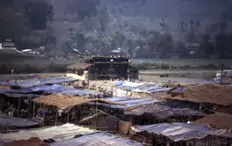
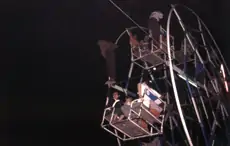 I fell very sick on the bus and, although my fellow passengers weren't aware of it, I reminded myself constantly that
vegetarian food is the best option when traveling in places like this. At one stage I wasn't even sure if I could continue the
three-hundred kilometer journey without stopping and seeking a doctor. But I fought it and spent my first
night in Hsipaw sleeping — for about sixteen hours! Thankfully the bug was gone when I woke up and, after resisting
the temptation of food for most of the day, I was able to attend the Baw-gyo Festival. I even ate there!
I fell very sick on the bus and, although my fellow passengers weren't aware of it, I reminded myself constantly that
vegetarian food is the best option when traveling in places like this. At one stage I wasn't even sure if I could continue the
three-hundred kilometer journey without stopping and seeking a doctor. But I fought it and spent my first
night in Hsipaw sleeping — for about sixteen hours! Thankfully the bug was gone when I woke up and, after resisting
the temptation of food for most of the day, I was able to attend the Baw-gyo Festival. I even ate there!
Originally a local, religious celebration in the Buddhist calendar
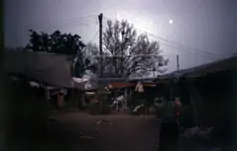
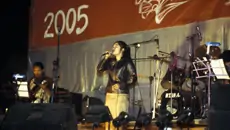 — the exact date determined by the Lunar cycle —
it soon became a festival attended by most of Shan State's ethnic minorities.
Today it is primarily a commercial event although its religious origins prevail under the veneer. I was fortunate
to find someone who led me away from the commercialized event and showed me people following the original
interpretation of it. Their candle-lit procession seemed much further away from the rock music concert that was
taking place on a stage only a few hundred meters away.
Attending festivals like the Baw-gyo Festival is among the best ways to
experience indigenous peoples' customs and traditions without feeling too much like an outsider.
— the exact date determined by the Lunar cycle —
it soon became a festival attended by most of Shan State's ethnic minorities.
Today it is primarily a commercial event although its religious origins prevail under the veneer. I was fortunate
to find someone who led me away from the commercialized event and showed me people following the original
interpretation of it. Their candle-lit procession seemed much further away from the rock music concert that was
taking place on a stage only a few hundred meters away.
Attending festivals like the Baw-gyo Festival is among the best ways to
experience indigenous peoples' customs and traditions without feeling too much like an outsider.
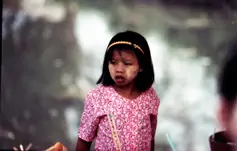
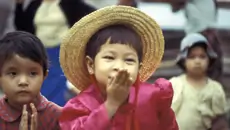
The next day I joined a group tour and we were guided around a handful of Shan and Pa-O
villages. These indigenous villages are no longer isolated from the modern world as they once were. Even so, visiting them as an outsider — used to comforts and technologies that the
developed world now takes for granted — it is easy to picture communities that continue to function more because of
their members than because of the outside world. As we were kissed good-bye I found myself once again completing a
leg of a journey that had been more satisfying and rewarding than I could have ever
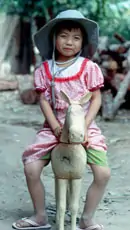 imagined.
imagined.
 Early the next morning, as my companions headed back west, I
continued my eastward journey to Lashio. Here it feels more like China than Burma; infrastructure and commerce are
very developed for a Burmese town of its size. It is no coincidence that
this town is close to the Chinese border. Of all my experiences in Lashio this billboard coffee advertisement
caught my attention the most. When I was young the only place I saw images of Padaung women with their
characteristic neck rings was in encyclopedias. It wasn't until I got close to the billboard that I
realized that the model in the photograph was a Padaung woman. I remember thinking how
truly globalized the world has become.
Early the next morning, as my companions headed back west, I
continued my eastward journey to Lashio. Here it feels more like China than Burma; infrastructure and commerce are
very developed for a Burmese town of its size. It is no coincidence that
this town is close to the Chinese border. Of all my experiences in Lashio this billboard coffee advertisement
caught my attention the most. When I was young the only place I saw images of Padaung women with their
characteristic neck rings was in encyclopedias. It wasn't until I got close to the billboard that I
realized that the model in the photograph was a Padaung woman. I remember thinking how
truly globalized the world has become.
My last stop in Shan State was planned to be for just one day volunteering to teach at St. Matthew's Orphanage Center in Pyin Oo Lwin. Things didn't quite go to plan... but that's another story.
Photography copyright © 1999 -
2025,
Ray Waddington. All rights reserved.
Text copyright © 1999 -
2025,
The Peoples of the World Foundation. All rights reserved.
Waddington, R., (2009) An Ethnic Journey through Shan State, Burma (Myanmar). The Peoples of the World Foundation. Retrieved November 17, 2025, from The Peoples of the World Foundation. <https://www.peoplesoftheworld.org/travelStory.jsp?travelStory=shan>
If you enjoyed reading this travel story, please consider buying us a coffee to help us cover the cost of hosting our web site. Please click on the link or scan the QR code. Thanks!

